Combining Eye-Tracking Technology and Subjective Evaluation to Determine Building Facade Color Combinations and Visual Quality
Abstract
:Featured Application
Abstract
1. Introduction
1.1. Research Status of Architectural Color
1.2. Visual Quality
1.3. Evolution of Research Techniques
1.4. Advantages of Eye-Tracking Technology
1.5. Research Questions and Objectives
- (1)
- Can eye-tracking metrics serve as new indicators for evaluating architectural color combinations?
- (2)
- How can the relationship between architectural color combinations and visual quality be quantitatively analyzed? What is the relationship between the two?
- (3)
- What common characteristics are shared by color combinations that receive high visual quality evaluations?
2. Materials and Methods
2.1. Research Subject
2.2. Color Selection
2.3. Simulation of Experimental Subjects
2.4. Subjects
2.5. Experimental Environment, Experimental Equipment, and Experimental Procedures
2.6. Selection of Eye-Tracking Data Metrics
2.7. Subjective Data Collection
2.8. Data Processing and Analysis
3. Results
3.1. Descriptive Analysis
3.2. Correlation Analysis
3.3. Regression Analysis
3.4. Summary
3.4.1. The Relationship between Hue and Visual Perception Evaluation
3.4.2. The Relationship between ΔE, ΔL, ΔC, Δh, and Visual Perception Evaluation
4. Discussion
4.1. Insights into Color Selection Related to Hue Factors
4.2. Experimental Insights into Color Element Differences
4.3. Strengths and Limitations of This Study
5. Conclusions
Author Contributions
Funding
Institutional Review Board Statement
Informed Consent Statement
Data Availability Statement
Conflicts of Interest
Appendix A. Methods and Research Variables
| Theme | Use Case | Methods | Data Analysis | |
| Building color | Colors of old residential facades in Shanghai, China | / | AHP hierarchical analysis | [4] |
| Color geography, the relationship between color and architectural form | Literature search | / | [9] | |
| Color and visual perception | Questionnaire, fNIRS extraction of hemodynamic responses | Descriptive analysis | [11] | |
| Xuzhou historical building color plan | On-site measurement, color card comparison | / | [56] | |
| Color planning for Shanghai Historic Landscape District | Expert scoring, questionnaires | Descriptive analysis | [12] | |
| Tall building height and color and perceived psychological repair | Questionnaires, measurement of psychological variables of recovery | Descriptive analysis, Pearson’s correlation, multiple regression, and analysis of variance (ANOVA) | [13] | |
| Evaluation of architectural color combinations | Questionnaire | Descriptive analysis, regression analysis | [50] | |
| Visual quality | Visual quality of natural landscapes within cities | Photographic model simulation of streetscapes, questionnaires | Scenic beauty estimation (SBE), Wilcoxon signed-rank test | [24] |
| Relationship between forest color and landscape aesthetics estimates | ArcGIS and FRAGSTATS extraction of spatial indices of color plates | One-way analysis of variance (ANOVA) and partial correlation analysis were used | [25] | |
| Visual quality of historic buildings and surrounding buildings | Questionnaire | One-way ANOVA, multiple linear regression analyses | [26] | |
| Visual quality of indoor light environments in buildings | Simulation of indoor models | Relative weight calculation | [19] | |
| Visual quality of street outdoor billboards | Photo survey | R.G.B bivariate histogram calculation | [22] | |
| Visual comfort and preference in specific indoor scenes | Forced-choice approach to psychophysical experiments | / | [27] | |
| Quality of visual perception of urban streets | Street view imaging technology | Salience detection algorithm combining simple priorities (SDSP) | [20] | |
| Perception of visual and auditory landscapes in urban environments | Customized deep learning (DL) models | / | [32] | |
| Eye movement technique | Evaluation of visual behavioral characteristics and psychological perception of forest water feature spaces | Eye-tracking techniques and psycho-perceptual questionnaires | Wilcoxon rank sum test, T test, correlation analysis | [42] |
| Balance and visual aesthetics of building facade compositions | Eye-tracking technology (building facade elements) | Descriptive analysis | [43] | |
| Proportion of landscape elements and residents’ evaluation of the attractiveness of urban complexes | Eye-tracking techniques (landscape element composition), online questionnaires | Descriptive analysis, correlation analysis | [44] | |
| Visual behavioral characteristics of built heritage and what factors influence visual perception | Eye movement techniques (visual search paths, gaze ratios) | Descriptive analysis, correlation analysis | [45] | |
| Influences on the visual characteristics of spatial elements in traditional Chinese commercial neighborhoods | Eye-tracking techniques (streetscape elements), semantic differentiation | Descriptive analysis, correlation analysis | [46] | |
| Key factors and landscape elements of concern in urban parks | Eye movement technology (green vision) | Descriptive analysis, correlation analysis | [67] | |
| Color elements and visual comfort in metro space | Eye-tracking techniques (color in indoor environments), questionnaires | Correlation analysis, regression analysis | [54] |
Appendix B. Color Combination and Color Value Correspondence
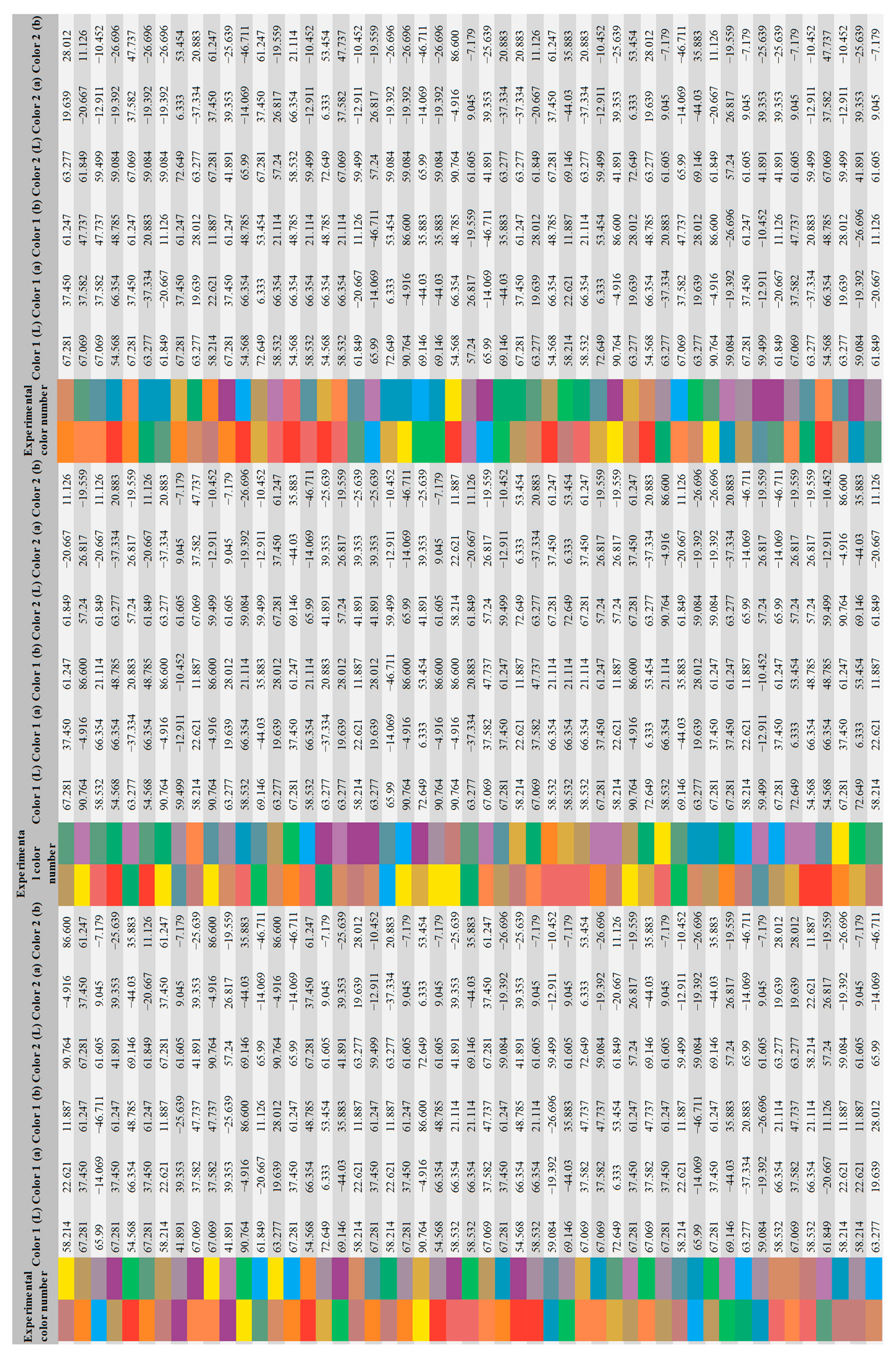
Appendix C. Questionnaire
| Architectural Color Visual Comfort Score | (1) very uncomfortable |
| (2) less comfortable | |
| (3) slightly uncomfortable | |
| (4) general | |
| (5) slightly comfortable | |
| (6) more comfortable | |
| (7) very comfortable | |
| Architectural color visual preference scoring | (1) very much disliked |
| (2) less favorable | |
| (3) slightly disliked | |
| (4) general | |
| (5) slightly preferred | |
| (6) prefer | |
| (7) favorite |
References
- Anter, K.F. Forming Spaces with Colour and Light: Trends in Architectural Practice and Swedish Colour Research. Colour Des. Creat. 2008, 2, 1–10. [Google Scholar]
- Jaglarz, A. Perception of Color in Architecture and Urban Space. Buildings 2023, 13, 2000. [Google Scholar] [CrossRef]
- Askari, A.H.; Soltani, S. Contribution of Building Façades to Attractive Streetscapes: Study of Two Main Streets in Kuala Lumpur City. JDBE 2018, 18, 29–40. [Google Scholar] [CrossRef]
- Wang, J.; Zhang, L.; Gou, A. Study of the Color Characteristics of Residential Buildings in Shanghai. Color Res. Appl. 2021, 46, 240–257. [Google Scholar] [CrossRef]
- Xu, Z.; Zheng, X. Roadmap of Moving Urban Colour toward Cultural Sustainability in China. Color Res. Appl. 2021, 46, 222–239. [Google Scholar] [CrossRef]
- Odetti, J.V. The Study of Color as a Component of Urban Cultural Construction: A Theoretical Reflection and Methodological Proposal. Color Res. Appl. 2023, 48, 453–467. [Google Scholar] [CrossRef]
- Manav, B. Color-emotion Associations, Designing Color Schemes for Urban Environment-architectural Settings. Color Res. Appl. 2017, 42, 631–640. [Google Scholar] [CrossRef]
- Chen, K.; Lin, H.; Chen, Y.-J.; Xu, Y.; Ding, S.; Guo, Y.; You, S. Do Consumers Have Colour Aesthetic Preferences for the Facade Materials of Condominium Buildings? Buildings 2024, 14, 557. [Google Scholar] [CrossRef]
- Gou, A. Method of Urban Color Plan Based on Spatial Configuration. Color Res. Appl. 2013, 38, 65–72. [Google Scholar] [CrossRef]
- Hogg, J.; Goodman, S.; Porter, T.; Mikellides, B.; Preddy, D.E. Dimensions and Determinants of Judgements of Colour Samples and a Simulated Interior Space by Architects and Non-Architects. Br. J. Psychol. 1979, 70, 231–242. [Google Scholar] [CrossRef]
- Shi, Y.; Tu, Y.; Wang, L.; Zhu, N.; Zhang, D. How Visual Discomfort Is Affected by Colour Saturation: A fNIRS Study. IEEE Photonics J. 2022, 14, 1–7. [Google Scholar] [CrossRef]
- Wang, Z.; Sun, H.; Li, J. Research on Architectural Color and Visual Comfort in Historic Landscape Areas. Buildings 2023, 13, 1004. [Google Scholar] [CrossRef]
- Zarghami, E.; Ghanbaran, A.; Karimimoshaver, M.; Saadativaghar, P. Effect of Height and Color of Tall Buildings on the Perceived Psychological Restoration of Residents. J. Archit. Plan. Res. 2019, 36, 321–342. [Google Scholar]
- Zhai, Y.; Gong, R.; Huo, J.; Fan, B. Building Façade Color Distribution, Color Harmony and Diversity in Relation to Street Functions: Using Street View Images and Deep Learning. ISPRS Int. J. Geo-Inf. 2023, 12, 224. [Google Scholar] [CrossRef]
- Wang, Z.; Shen, M.; Huang, Y. Exploring the Impact of Facade Color Elements on Visual Comfort in Old Residential Buildings in Shanghai: Insights from Eye-Tracking Technology. Buildings 2024, 14, 1758. [Google Scholar] [CrossRef]
- Vasiljevic-Tomic, D.; Maric, I. Colour in the City: Principles of Nature-Climate Characteristics. Facta Univ. Archit. Civ. Eng. 2011, 9, 315–323. [Google Scholar] [CrossRef]
- Wan, J.; Zhou, Y.; Li, Y.; Su, Y.; Cao, Y.; Zhang, L.; Ying, L.; Deng, W. Research on Color Space Perceptions and Restorative Effects of Blue Space Based on Color Psychology: Examination of the Yijie District of Dujiangyan City as an Example. Int. J. Environ. Res. Public Health 2020, 17, 3137. [Google Scholar] [CrossRef]
- Serra, J.; García, Á.; Torres, A.; Llopis, J. Color Composition Features in Modern Architecture. Color Res. Appl. 2012, 37, 126–133. [Google Scholar] [CrossRef]
- Zanon, S.; Callegaro, N.; Albatici, R. A Novel Approach for the Definition of an Integrated Visual Quality Index for Residential Buildings. Appl. Sci. 2019, 9, 1579. [Google Scholar] [CrossRef]
- Cheng, L.; Chu, S.; Zong, W.; Li, S.; Wu, J.; Li, M. Use of Tencent Street View Imagery for Visual Perception of Streets. ISPRS Int. J. Geo-Inf. 2017, 6, 265. [Google Scholar] [CrossRef]
- Bharmoria, R.; Sharma, V. Analyzing the Urban Sustainable Development Impact of Degraded Visual Quality on Streetscape Causing Visual Variation: A Case of Dharamshala, Himachal Pradesh. Environ. Dev. Sustain. 2024. [Google Scholar] [CrossRef]
- Adam, M.; Al-Sharaa, A.; Ab Ghafar, N.; Mundher, R.; Abu Bakar, S.; Alhasan, A. The Effects of Colour Content and Cumulative Area of Outdoor Advertisement Billboards on the Visual Quality of Urban Streets. ISPRS Int. J. Geo-Inf. 2022, 11, 630. [Google Scholar] [CrossRef]
- Mundher, R.; Abu Bakar, S.; Al-Helli, M.; Gao, H.; Al-Sharaa, A.; Mohd Yusof, M.J.; Maulan, S.; Aziz, A. Visual Aesthetic Quality Assessment of Urban Forests: A Conceptual Framework. Urban Sci. 2022, 6, 79. [Google Scholar] [CrossRef]
- Ma, B.; Hauer, R.J.; Xu, C. Effects of Design Proportion and Distribution of Color in Urban and Suburban Green Space Planning to Visual Aesthetics Quality. Forests 2020, 11, 278. [Google Scholar] [CrossRef]
- Zhang, Z.; Qie, G.; Wang, C.; Jiang, S.; Li, X.; Li, M. Relationship between Forest Color Characteristics and Scenic Beauty: Case Study Analyzing Pictures of Mountainous Forests at Sloped Positions in Jiuzhai Valley, China. Forests 2017, 8, 63. [Google Scholar] [CrossRef]
- Bu, X.; Chen, X.; Wang, S.; Yuan, Y.; Han, C. The Influence of Newly Built High-Rise Buildings on Visual Impact Assessment of Historic Urban Landscapes: A Case Study of Xi’an Bell Tower. J. Asian Archit. Build. Eng. 2022, 21, 1304–1319. [Google Scholar] [CrossRef]
- Wang, Q.; Xu, H.; Zhang, F.; Wang, Z. Influence of Color Temperature on Comfort and Preference for LED Indoor Lighting. Optik 2017, 129, 21–29. [Google Scholar] [CrossRef]
- Markopoulos, E.; Goonetilleke, R.S.; Ho, A.G.; Luximon, Y. (Eds.) Advances in Creativity, Innovation, Entrepreneurship and Communication of Design: Proceedings of the AHFE 2021 Virtual Conferences on Creativity, Innovation and Entrepreneurship, and Human Factors in Communication of Design, USA, 25–29 July 2021; Lecture Notes in Networks and Systems; Springer International Publishing: Cham, Switzerland, 2021; Volume 276, ISBN 978-3-030-80093-2. [Google Scholar]
- Sarasso, P.; Neppi-Modona, M.; Sacco, K.; Ronga, I. “Stopping for Knowledge”: The Sense of Beauty in the Perception-Action Cycle. Neurosci. Biobehav. Rev. 2020, 118, 723–738. [Google Scholar] [CrossRef]
- Long, Y.; Liu, L. How Green Are the Streets? An Analysis for Central Areas of Chinese Cities Using Tencent Street View. PLoS ONE 2017, 12, e0171110. [Google Scholar] [CrossRef] [PubMed]
- Hu, K.; Xu, Z.; Wang, X.; Wang, Y.; Li, H.; Zhang, Y. Research on Street Color Environment Perception Based on CEP-KASS Framework. Buildings 2023, 13, 2649. [Google Scholar] [CrossRef]
- Verma, D.; Jana, A.; Ramamritham, K. Predicting Human Perception of the Urban Environment in a Spatiotemporal Urban Setting Using Locally Acquired Street View Images and Audio Clips. Build. Environ. 2020, 186, 107340. [Google Scholar] [CrossRef]
- Csikszentmihalyi, M.; Larson, R. The Ecology of Adolescent Activity and Experience. J. Youth Adolesc. 1977, 6, 281–294. [Google Scholar] [CrossRef] [PubMed]
- Worthy, D.A. An Examination of the Effects of Eye-Tracking on Behavior in Psychology Experiments. Behav. Res. Methods 2024, 56, 6812–6825. [Google Scholar] [CrossRef] [PubMed]
- Mele, M.L.; Federici, S. Gaze and Eye-Tracking Solutions for Psychological Research. Cogn. Process. 2012, 13, 261–265. [Google Scholar] [CrossRef] [PubMed]
- Hamamé, C.M.; Vidal, J.R.; Perrone-Bertolotti, M.; Ossandón, T.; Jerbi, K.; Kahane, P.; Bertrand, O.; Lachaux, J.-P. Functional Selectivity in the Human Occipitotemporal Cortex during Natural Vision: Evidence from Combined Intracranial EEG and Eye-Tracking. NeuroImage 2014, 95, 276–286. [Google Scholar] [CrossRef]
- Yarbus, A.L. Eye Movements and Vision; Springer US: Boston, MA, USA, 1967; ISBN 978-1-4899-5381-0. [Google Scholar]
- Bix, L.; Seo, W.; Sundar, R.P. The Effect of Colour Contrast on Consumers’ Attentive Behaviours and Perception of Fresh Produce. Packag. Technol. Sci. 2013, 26, 96–104. [Google Scholar] [CrossRef]
- Siegrist, M. Consumers’ Food Selection Behaviors in Three-Dimensional (3D) Virtual Reality. Food Res. Int. 2019, 117, 50–59. [Google Scholar] [CrossRef]
- Shoval, N.; Schvimer, Y.; Tamir, M. Real-Time Measurement of Tourists’ Objective and Subjective Emotions in Time and Space. J. Travel Res. 2018, 57, 3–16. [Google Scholar] [CrossRef]
- Scott, N.; Zhang, R.; Le, D.; Moyle, B. A Review of Eye-Tracking Research in Tourism. Curr. Issues Tour. 2019, 22, 1244–1261. [Google Scholar] [CrossRef]
- Gao, Y.; Sun, X.M.; Zhang, T.; Zhan, H. Analysis on the Characteristics of Eye Movement and the Evaluation of Psychological Perception for Forest Waterscape Space. IOP Conf. Ser. Earth Environ. Sci. 2021, 626, 012007. [Google Scholar] [CrossRef]
- Hasse, C.; Weber, R. Eye Movements on Facades: The Subjective Perception of Balance in Architecture and Its Link to Aesthetic Judgment. Empir. Stud. Arts 2012, 30, 7–22. [Google Scholar] [CrossRef]
- Li, J.; Zhang, Z.; Jing, F.; Gao, J.; Ma, J.; Shao, G.; Noel, S. An Evaluation of Urban Green Space in Shanghai, China, Using Eye Tracking. Urban For. Urban Green. 2020, 56, 126903. [Google Scholar] [CrossRef]
- Li, N.; Zhang, S.; Xia, L.; Wu, Y. Investigating the Visual Behavior Characteristics of Architectural Heritage Using Eye-Tracking. Buildings 2022, 12, 1058. [Google Scholar] [CrossRef]
- Li, Z.; Sun, X.; Zhao, S.; Zuo, H. Integrating Eye-Movement Analysis and the Semantic Differential Method to Analyze the Visual Effect of a Traditional Commercial Block in Hefei, China. Front. Archit. Res. 2021, 10, 317–331. [Google Scholar] [CrossRef]
- Lv, J.; Xu, X.; Ding, N. Research on the Quantitative Method of Cognitive Loading in a Virtual Reality System. Information 2019, 10, 170. [Google Scholar] [CrossRef]
- Orquin, J.L.; Loose, S.M. Attention and Choice: A Review on Eye Movements in Decision Making. Acta Psychol. 2013, 144, 190–206. [Google Scholar] [CrossRef] [PubMed]
- Guo, H.Y.; Cai, Y.N. China’s Urban Architecture and Environmental Color Practicein in Ten Years. AMM 2012, 174–177, 2512–2515. [Google Scholar] [CrossRef]
- Li, K.; Zheng, Z.; Wang, P.; Yan, W. Research on the Colour Preference and Harmony of the two-colour Combination Buildings. Color Res. Appl. 2022, 47, 980–991. [Google Scholar] [CrossRef]
- De La Fuente Suárez, L.A. Subjective Experience and Visual Attention to a Historic Building: A Real-World Eye-Tracking Study. Front. Archit. Res. 2020, 9, 774–804. [Google Scholar] [CrossRef]
- Kiefer, P.; Giannopoulos, I.; Raubal, M.; Duchowski, A. Eye Tracking for Spatial Research: Cognition, Computation, Challenges. Spat. Cogn. Comput. 2017, 17, 1–19. [Google Scholar] [CrossRef]
- Wang, H.; Tang, J.; Xu, P.; Chen, R.; Yao, H. Research on the Influence Mechanism of Street Vitality in Mountainous Cities Based on a Bayesian Network: A Case Study of the Main Urban Area of Chongqing. Land 2022, 11, 728. [Google Scholar] [CrossRef]
- Zhang, L.; Li, X.; Li, C.; Zhang, T. Research on Visual Comfort of Color Environment Based on the Eye-Tracking Method in Subway Space. J. Build. Eng. 2022, 59, 105138. [Google Scholar] [CrossRef]
- Hanada, M. Correspondence Analysis of Color–Emotion Associations. Color Res. Appl. 2018, 43, 224–237. [Google Scholar] [CrossRef]
- Hong, X.; Ji, X.; Wu, Z. Architectural Colour Planning Strategy and Planning Implementation Evaluation of Historical and Cultural Cities Based on Different Urban Zones in Xuzhou (China). Color Res. Appl. 2022, 47, 424–453. [Google Scholar] [CrossRef]
- Wang, J.; Zhang, L.; Gou, A. Study on the Preference of City Color Image Selection Based on the Logistic Model: A Case Study of Shanghai. Color Res. Appl. 2020, 45, 542–557. [Google Scholar] [CrossRef]
- Labib, S.M.; Lindley, S.; Huck, J.J. Spatial Dimensions of the Influence of Urban Green-Blue Spaces on Human Health: A Systematic Review. Environ. Res. 2020, 180, 108869. [Google Scholar] [CrossRef]
- Kaya, N.; Crosby, M. Color Associations with Different Building Types: An Experimental Study on American College Students. Color Res. Appl. 2006, 31, 67–71. [Google Scholar] [CrossRef]
- Gou, A.; Wang, J. Research on the Location Characters of Urban Color Plan in China. Color Res. Appl. 2008, 33, 68–76. [Google Scholar] [CrossRef]
- He, F. Gender Differences in Color Perceptions and Preferences of Urban Façades Based on a Virtual Comparison. Build. Environ. 2023, 245, 110907. [Google Scholar] [CrossRef]
- Brychtova, A.; Coltekin, A. An Empirical User Study for Measuring the Influence of Colour Distance and Font Size in Map Reading Using Eye Tracking. Cartogr. J. 2016, 53, 202–212. [Google Scholar] [CrossRef]
- Massaro, D.; Savazzi, F.; Di Dio, C.; Freedberg, D.; Gallese, V.; Gilli, G.; Marchetti, A. When Art Moves the Eyes: A Behavioral and Eye-Tracking Study. PLoS ONE 2012, 7, e37285. [Google Scholar] [CrossRef]
- Zhang, L.; Dempsey, N.; Cameron, R. ‘Blossom Buddies’—How Do Flower Colour Combinations Affect Emotional Response and Influence Therapeutic Landscape Design? Landsc. Urban Plan. 2024, 248, 105099. [Google Scholar] [CrossRef]
- Abromavičius, V.; Serackis, A. Eye and EEG Activity Markers for Visual Comfort Level of Images. Biocybern. Biomed. Eng. 2018, 38, 810–818. [Google Scholar] [CrossRef]
- Lu, M.; Hu, S.; Mao, Z.; Liang, P.; Xin, S.; Guan, H. Research on Work Efficiency and Light Comfort Based on EEG Evaluation Method. Build. Environ. 2020, 183, 107122. [Google Scholar] [CrossRef]
- Gholami, Y.; Taghvaei, S.H.; Norouzian-Maleki, S.; Mansouri Sepehr, R. Identifying the Stimulus of Visual Perception Based on Eye-Tracking in Urban Parks: Case Study of Mellat Park in Tehran. J. For. Res. 2021, 26, 91–100. [Google Scholar] [CrossRef]
- Forbes, S.H.; Plunkett, K. Colour Perception Changes with Basic Colour Word Comprehension. Dev. Sci. 2023, 26, e13406. [Google Scholar] [CrossRef]
- Babiker, A.; Faye, I.; Prehn, K.; Malik, A. Machine Learning to Differentiate Between Positive and Negative Emotions Using Pupil Diameter. Front. Psychol. 2015, 6, 1921. [Google Scholar] [CrossRef]
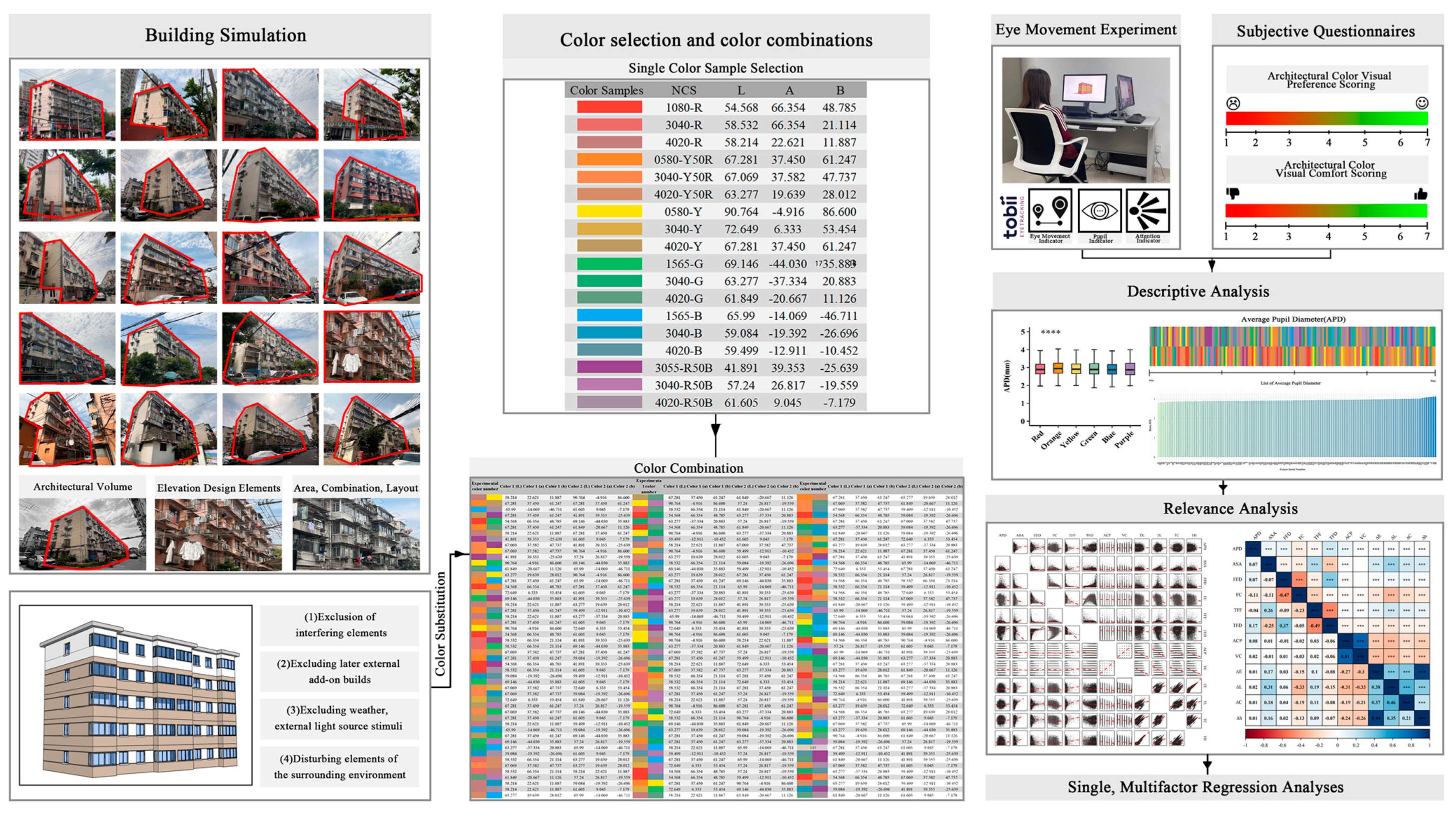

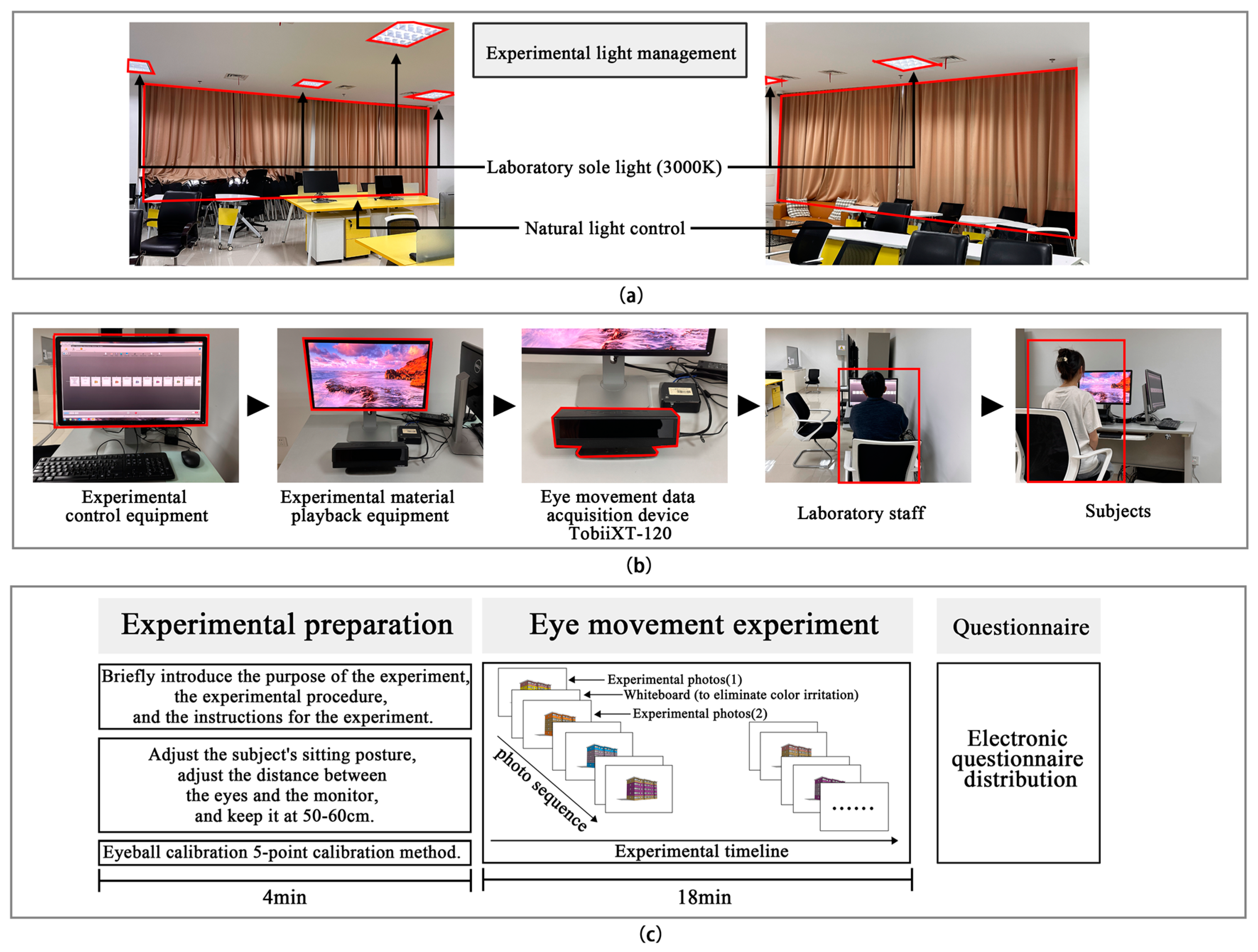
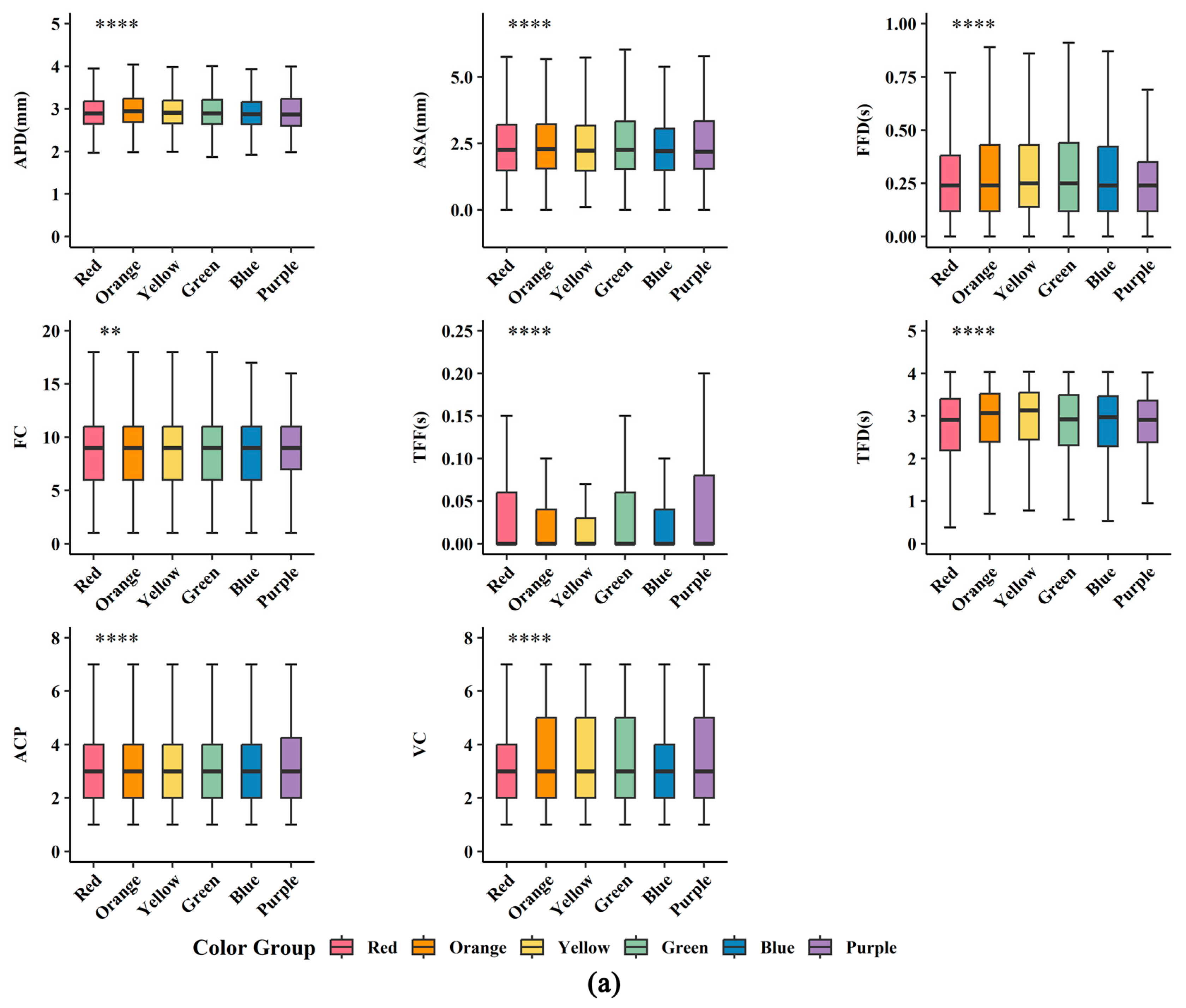
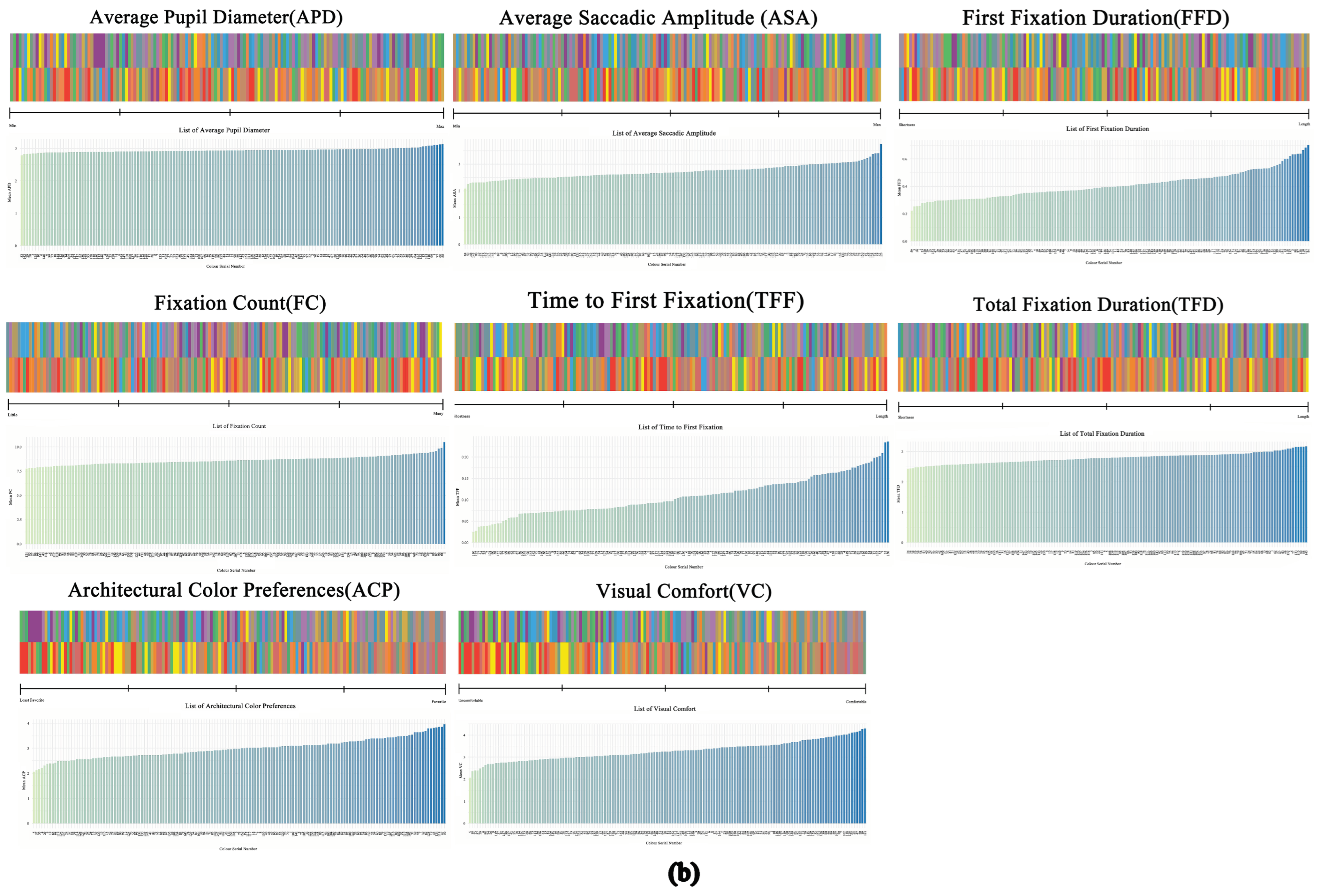
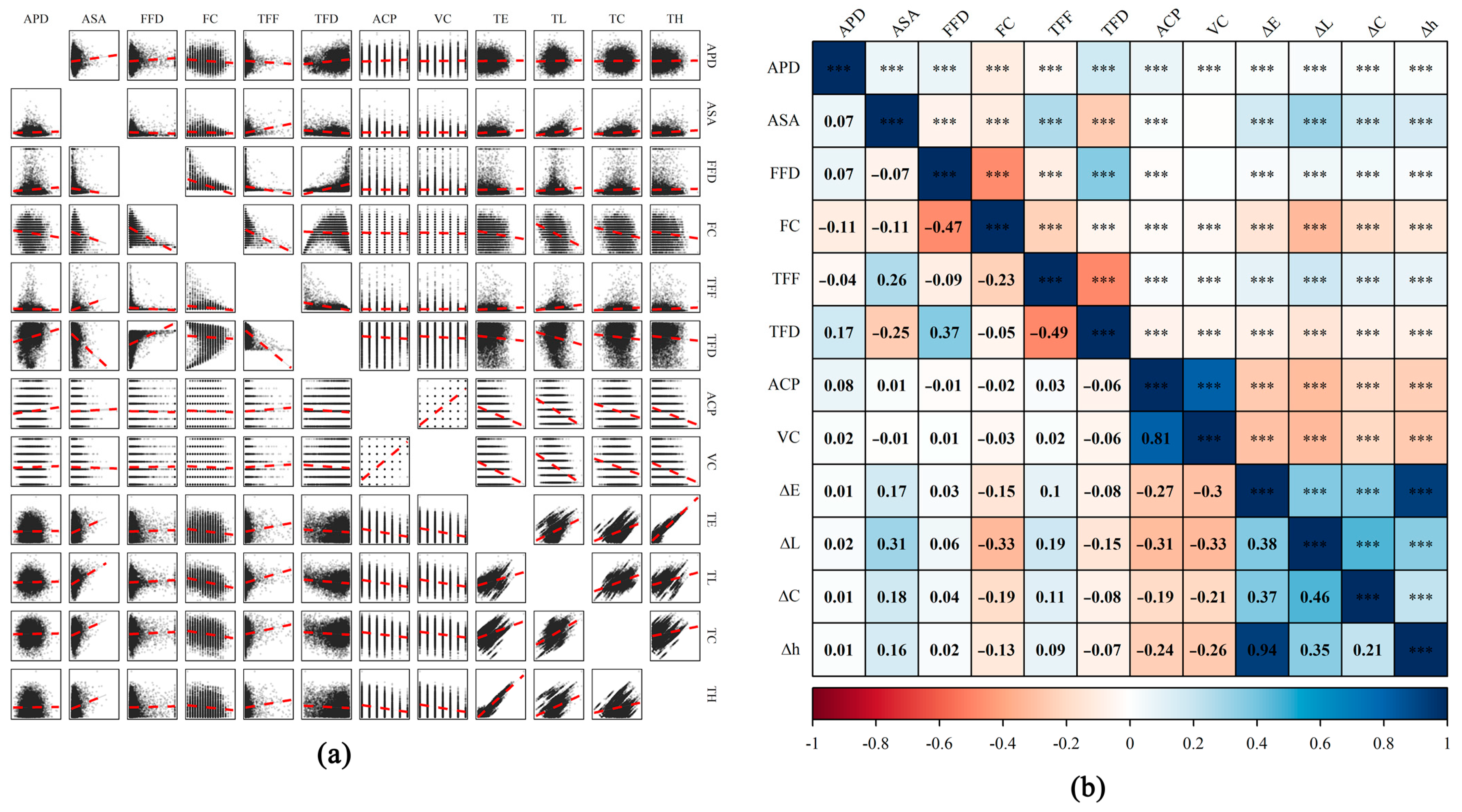
| Eye Movement Index | Abbreviations | Meaning |
|---|---|---|
| First Fixation Duration | FFD (s) | The duration of the first fixation within the area of interest, representing the ease or difficulty of recognizing or finding attractiveness of the experimental object. |
| Fixation Count | FC (count) | The sum of all fixation durations within the area of interest, representing the level of interest of the participants toward the experimental object. |
| Time to First Fixation | TFF (s) | The time taken by the participants to first fixate on an area of interest, i.e., the duration until the first entry into the area of interest. It represents the visual saliency of the experimental material. |
| Total Fixation Duration | TFD (s) | The sum of the durations of all fixations within the area of interest. It represents the level of interest the participants have in the experimental stimulus. |
| Average Pupil Diameter | APD (mm) | It directly reflects the level of visual stimulation perceived by the participants toward the stimuli. |
| Average Saccadic Amplitude | ASA (degrees) | The average distance between saccades, typically measured in degrees of visual angle. Eye movements, facilitated by involuntary saccades, help alleviate visual fatigue and reflect the ease of information processing by the participants in the experiment. |
| Evaluation Indicators | Abbreviations | Subjective Rating | ||||||
|---|---|---|---|---|---|---|---|---|
| Architectural Color Preferences | ACP | 1 | 2 | 3 | 4 | 5 | 6 | 7 |
| Visual Comfort | VC | 1 | 2 | 3 | 4 | 5 | 6 | 7 |
| Unstandardized Coefficients | Standardized Coefficients | |||||
|---|---|---|---|---|---|---|
| Variable | Factors | β | SE | β | t | Sig. |
| APD | ΔE | <0.001 | <0.001 | 0.013 | 3.207 | 0.001 |
| ΔL | 0.001 | <0.001 | 0.022 | 5.398 | <0.001 | |
| ΔC | <0.001 | <0.001 | 0.014 | 3.329 | 0.001 | |
| Δh | <0.001 | <0.001 | 0.011 | 2.765 | 0.006 | |
| ASA | ΔE | 0.012 | <0.001 | 0.167 | 40.988 | <0.001 |
| ΔL | 0.038 | <0.001 | 0.306 | 77.756 | <0.001 | |
| ΔC | 0.013 | <0.001 | 0.176 | 43.219 | <0.001 | |
| Δh | 0.012 | <0.001 | 0.157 | 38.334 | <0.001 | |
| FFD | ΔE | 0.001 | <0.001 | 0.028 | 6.721 | <0.001 |
| ΔL | 0.002 | <0.001 | 0.06 | 14.425 | <0.001 | |
| ΔC | 0.001 | <0.001 | 0.045 | 10.794 | <0.001 | |
| Δh | 0.001 | <0.001 | 0.023 | 5.49 | <0.001 | |
| FC | ΔE | −0.019 | 0.001 | −0.148 | −36.253 | <0.001 |
| ΔL | −0.069 | 0.001 | −0.326 | −83.298 | <0.001 | |
| ΔC | −0.023 | 0.001 | −0.189 | −46.572 | <0.001 | |
| Δh | −0.016 | 0.001 | −0.127 | −31.068 | <0.001 | |
| TFF | ΔE | 0.001 | <0.001 | 0.096 | 23.199 | <0.001 |
| ΔL | 0.004 | <0.001 | 0.189 | 46.492 | <0.001 | |
| ΔC | 0.001 | <0.001 | 0.111 | 27.051 | <0.001 | |
| Δh | 0.001 | <0.001 | 0.086 | 20.855 | <0.001 | |
| TFD | ΔE | −0.003 | <0.001 | −0.078 | −18.837 | <0.001 |
| ΔL | −0.008 | <0.001 | −0.15 | −36.749 | <0.001 | |
| ΔC | −0.003 | <0.001 | −0.079 | −19.115 | <0.001 | |
| Δh | −0.002 | <0.001 | −0.07 | −17.001 | <0.001 | |
| ACP | ΔE | −0.015 | <0.001 | −0.268 | −67.297 | <0.001 |
| ΔL | −0.029 | <0.001 | −0.311 | −79.059 | <0.001 | |
| ΔC | −0.011 | <0.001 | −0.19 | −46.815 | <0.001 | |
| Δh | −0.014 | <0.001 | −0.24 | −59.762 | <0.001 | |
| VC | ΔE | −0.017 | <0.001 | −0.297 | −75.171 | <0.001 |
| ΔL | −0.032 | <0.001 | −0.326 | −83.474 | <0.001 | |
| ΔC | −0.012 | <0.001 | −0.207 | −51.088 | <0.001 | |
| Δh | −0.016 | <0.001 | −0.264 | −66.089 | <0.001 | |
| Unstandardized Coefficients | Standardized Coefficients | |||||
|---|---|---|---|---|---|---|
| Variable | Factors | β | SE | β | t | Sig. |
| APD | Intercept | 2.944 | 0.004 | 687.156 | <0.001 | |
| ΔE | <0.001 | <0.001 | 0.012 | 0.831 | 0.406 | |
| ΔL | <0.001 | <0.001 | 0.02 | 3.971 | <0.001 | |
| ΔC | <0.001 | <0.001 | 0.002 | 0.335 | 0.738 | |
| Δh | >−0.001 | <0.001 | −0.007 | −0.503 | 0.615 | |
| ASA | Intercept | 3.293 | 0.022 | 153.04 | <0.001 | |
| ΔE | 0.002 | 0.001 | 0.022 | 1.657 | 0.097 | |
| ΔL | 0.034 | 0.001 | 0.27 | 57.769 | <0.001 | |
| ΔC | 0.003 | <0.001 | 0.036 | 6.904 | <0.001 | |
| Δh | 0.002 | 0.001 | 0.033 | 2.547 | 0.011 | |
| FFD | Intercept | 0.451 | 0.007 | 67.425 | <0.001 | |
| ΔE | <0.001 | <0.001 | 0.008 | 0.55 | 0.582 | |
| ΔL | 0.002 | <0.001 | 0.05 | 10.114 | <0.001 | |
| ΔC | <0.001 | <0.001 | 0.02 | 3.708 | <0.001 | |
| Δh | >−0.001 | <0.001 | −0.006 | −0.476 | 0.634 | |
| FC | Intercept | 7.379 | 0.036 | 203.959 | <0.001 | |
| ΔE | −0.011 | 0.002 | −0.089 | −6.71 | <0.001 | |
| ΔL | −0.064 | 0.001 | −0.303 | −65.304 | <0.001 | |
| ΔC | −0.004 | 0.001 | −0.03 | −5.925 | <0.001 | |
| Δh | 0.009 | 0.002 | 0.07 | 5.48 | <0.001 | |
| TFF | Intercept | 0.172 | 0.004 | 47.659 | <0.001 | |
| ΔE | <0.001 | <0.001 | 0.032 | 2.311 | 0.021 | |
| ΔL | 0.003 | <0.001 | 0.17 | 35.145 | <0.001 | |
| ΔC | <0.001 | <0.001 | 0.023 | 4.234 | <0.001 | |
| Δh | <0.001 | <0.001 | −0.009 | −0.667 | 0.505 | |
| TFD | Intercept | 2.648 | 0.01 | 262.649 | <0.001 | |
| ΔE | −0.002 | <0.001 | −0.048 | −3.453 | 0.001 | |
| ΔL | −0.008 | <0.001 | −0.141 | −28.945 | <0.001 | |
| ΔC | <0.001 | <0.001 | −0.001 | −0.193 | 0.847 | |
| Δh | 0.001 | <0.001 | 0.025 | 1.86 | 0.063 | |
| ACP | Intercept | 2.912 | 0.016 | 181.793 | <0.001 | |
| ΔE | −0.016 | 0.001 | −0.28 | −21.385 | <0.001 | |
| ΔL | −0.023 | <0.001 | −0.247 | −53.705 | <0.001 | |
| ΔC | <0.001 | <0.001 | 0.006 | 1.111 | 0.267 | |
| Δh | 0.006 | 0.001 | 0.109 | 8.645 | <0.001 | |
| VC | Intercept | 3.251 | 0.016 | 198.37 | <0.001 | |
| ΔE | −0.019 | 0.001 | −0.331 | −25.594 | <0.001 | |
| ΔL | −0.025 | <0.001 | −0.252 | −55.491 | <0.001 | |
| ΔC | <0.001 | <0.001 | 0.005 | 0.993 | 0.321 | |
| Δh | 0.008 | 0.001 | 0.135 | 10.867 | <0.001 | |
Disclaimer/Publisher’s Note: The statements, opinions and data contained in all publications are solely those of the individual author(s) and contributor(s) and not of MDPI and/or the editor(s). MDPI and/or the editor(s) disclaim responsibility for any injury to people or property resulting from any ideas, methods, instructions or products referred to in the content. |
© 2024 by the authors. Licensee MDPI, Basel, Switzerland. This article is an open access article distributed under the terms and conditions of the Creative Commons Attribution (CC BY) license (https://creativecommons.org/licenses/by/4.0/).
Share and Cite
Wang, Z.; Shen, M.; Huang, Y. Combining Eye-Tracking Technology and Subjective Evaluation to Determine Building Facade Color Combinations and Visual Quality. Appl. Sci. 2024, 14, 8227. https://doi.org/10.3390/app14188227
Wang Z, Shen M, Huang Y. Combining Eye-Tracking Technology and Subjective Evaluation to Determine Building Facade Color Combinations and Visual Quality. Applied Sciences. 2024; 14(18):8227. https://doi.org/10.3390/app14188227
Chicago/Turabian StyleWang, Zhanzhu, Maoting Shen, and Yongming Huang. 2024. "Combining Eye-Tracking Technology and Subjective Evaluation to Determine Building Facade Color Combinations and Visual Quality" Applied Sciences 14, no. 18: 8227. https://doi.org/10.3390/app14188227
APA StyleWang, Z., Shen, M., & Huang, Y. (2024). Combining Eye-Tracking Technology and Subjective Evaluation to Determine Building Facade Color Combinations and Visual Quality. Applied Sciences, 14(18), 8227. https://doi.org/10.3390/app14188227









